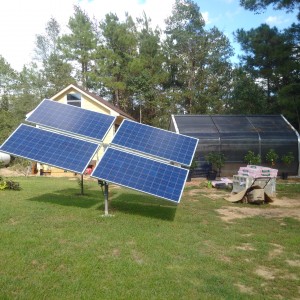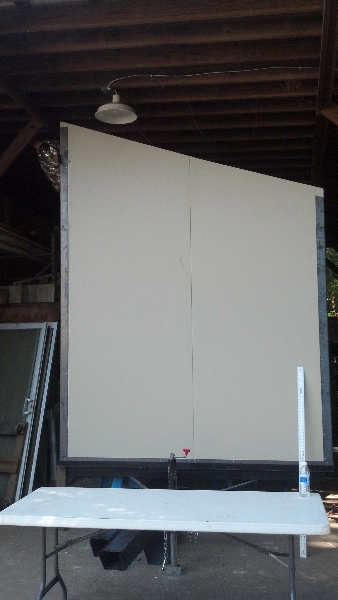Off Grid Solar At Aquaponics Greenhouse

 A rural customer recently hired me to install an off-grid 1,200 watt solar PV system to operate the fans and pumps in their greenhouse behind and to the right of the solar array in the picture above. With the help of Bill Swann, a retired but active solar enthusiast, we added a solar tracking unit to increase the efficiency of the solar array by 20+ percent.
A rural customer recently hired me to install an off-grid 1,200 watt solar PV system to operate the fans and pumps in their greenhouse behind and to the right of the solar array in the picture above. With the help of Bill Swann, a retired but active solar enthusiast, we added a solar tracking unit to increase the efficiency of the solar array by 20+ percent.
What was interesting about this job was that it combined my interest in solar with an aquaponics system (installed by others) to grow fish and veggies and is totally off the grid. We also installed a 500 gallon propane tank and 2,000 watt Honda generator as a back up to the solar system. (remember the 4 months of constant rain we had January-April in 2015?).
The point was that the owners didn’t want the fish to die and the system to crash because of a power outage. They “prepared for the worst and hope for the best” and that is what the Boy Scouts taught me 50 years ago! It’s still true and probably applies more that ever with the way things are going around the world these days.
I sized the system to be able to run for up to four days without any input from the panels. The air and water pump use a minimal amount of power but the two big fans running 10 hours a day in the heat of the summer can really burn up some kilowatt hours. We put timers on them to make sure they didn’t run when it got cooler at night.
The solar tracking concept is something Bill and I are going to work on to improve. Since this is the first “off-grid” system he has installed a tracker on we discussed the need for a DC (direct current) motor to move the panels instead of having to run a 11o volt wire and plug back from the invertor. Even though the motor uses a minimum amount of power, using 110 v. means extra labor and material. So Bill ordered a smaller DC motor and is playing with it now to make it work with the arduino chip he uses in the tracker.
Another interesting note is the yellow “Tiny House” behind the solar array on the left. That is where we put the batteries, charge controller and inverter. It houses a water well with an old fashioned hand pump that I thought was clever. I hadn’t seen one of those in years and it was installed as a back up to the electric pump used for the well.
We learn something new every day!!













